The Place Where We Shelter
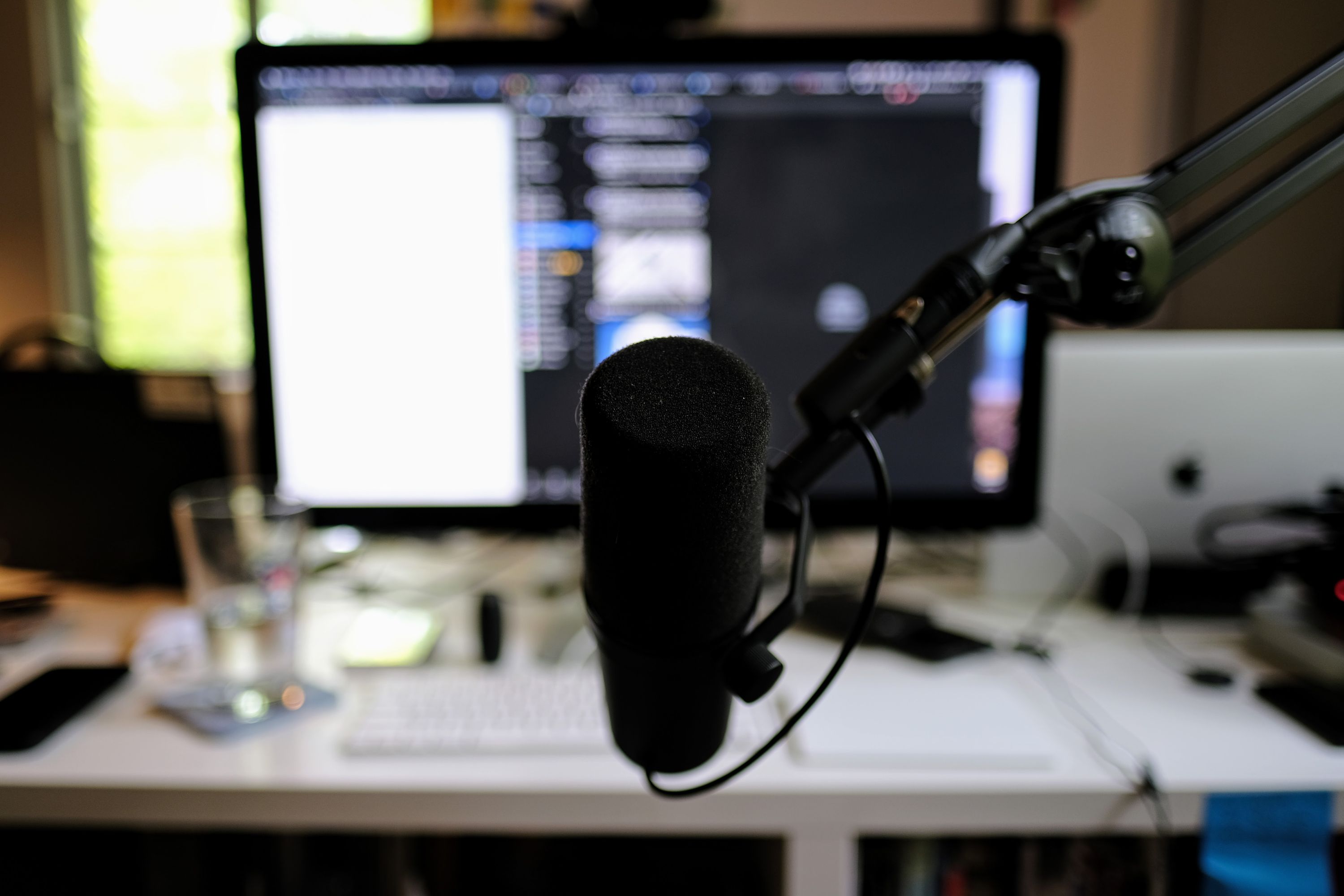
If the human eye suffered the same burn-in effect that some screens do, this would be the image now set against everything else for me. For the last four months, this has been my most frequent view — my little window from a little room through which I look onto a big, changing world.
Like you, I’ve been sheltering in place for some months now. Sheltering in Place. If that isn’t the most gentle rendering of our present reality, I don’t know what is. But I must admit, compared to what it could have been — and could still be — it has been gentle.
Don’t get me wrong: it has also been hard. My daughter’s school closed on March 13, and so my wife and I have been juggling our schedules every day in order to make working at home with a three-year-old at least a functional situation.
Unfortunately, right now functional means barely keeping our heads above work-water and holding fast the pre-pandemic line on our daughter’s screen time. And so it also means working after her bedtime and often on weekends because of lost time Monday through Friday. And it also means keeping the anxieties we all have at bay — pretending like our worries don’t come from real threats — just so we can write some emails, attend some meetings, make some boxes, preserve the status quo. But we’re making it work. And more importantly, we are grateful to do so. We’re both still working and everyone is healthy. We’re even having a good time together.
Likewise, we were fortunate to have a home-office already set up, though neither of us primarily worked from here prior to March. Back then, this room seemed like (was) such a luxury. If you had asked me then how much time we typically spend in it, I’d have said something like five hours a week, maybe less? Still unmeasured, I’d guess that now, the three of us spend upwards of that each day in here. In this little room.
Before the pandemic, if I had imagined spending four months stuck at home, the three of us spending most of the day in just one of the rooms of our house, our movements limited to a mile radius on foot, wearing masks everywhere we go, my car dead in the driveway from lack of use, food stockpiled in the pantry, etc. etc. etc., I’d have thought it some kind of bizarre prison. But today, I marvel at how lucky we are — how good it has been, our time in this little room.
And so I thought I’d share a bit of this space with you, and a few stray thoughts that come from within it. Consider this your day’s “office inspiration” but without the freshly unboxed sterility of the hyper-minimal just-so-ness en vogue right now. These pictures were taken yesterday, by me, without any cleaning up or hiding of things. This is a real room. This is how things actually are here.
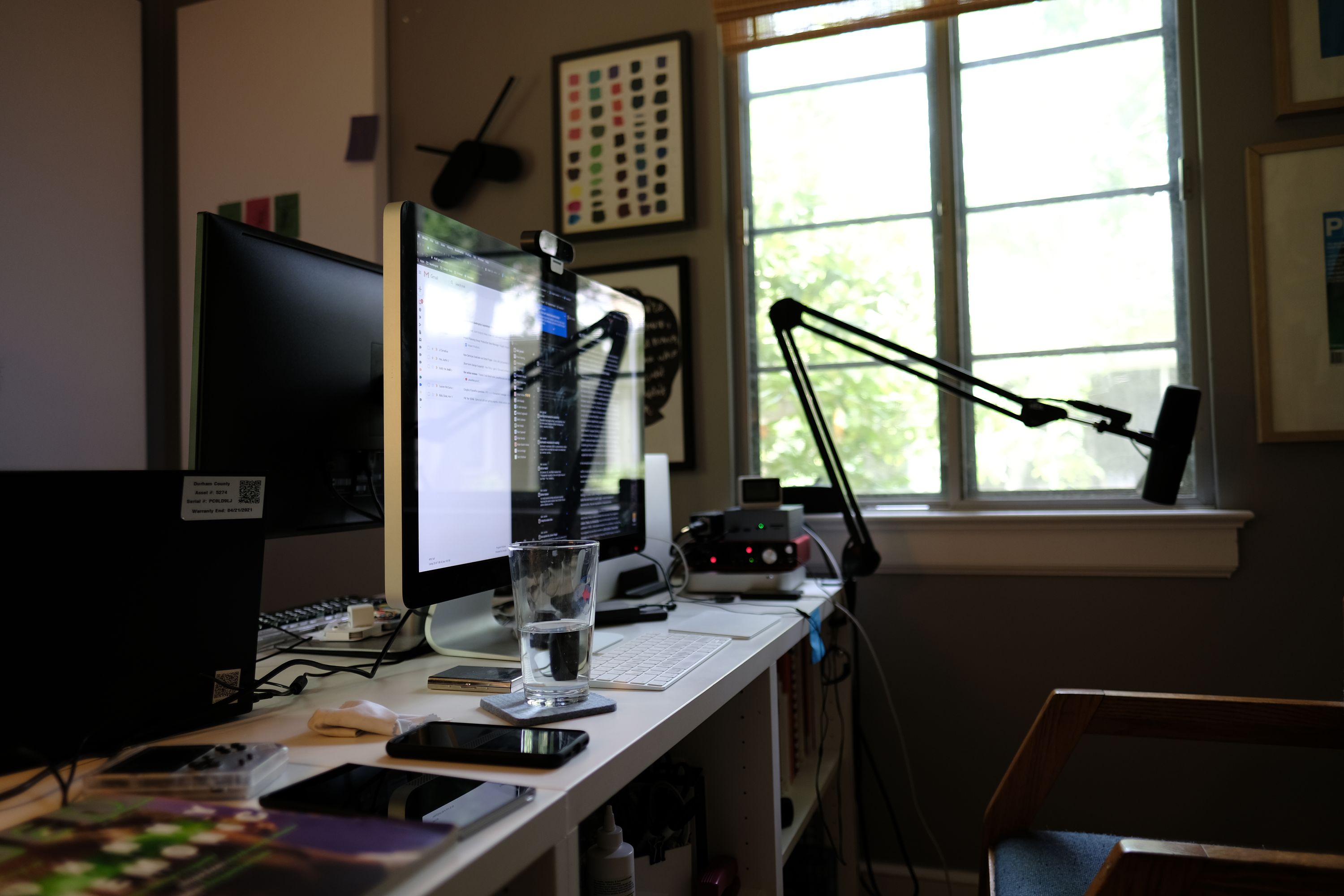
While we did have a home office set up before the pandemic, it wasn’t really optimized for all-day use — not for one person, let alone two. So, since we started using it that way, things have moved around in here a few times. We had been using a desk I’d made that was right up against a wall, but there wasn’t enough space on it for two workstations. I ended up getting rid of that desk, taking two shelving units that had been side-by-side against another wall, turning them back-to-back, and putting them in the middle of the room. It’s not ergonomically ideal, as you’ll see in some other pictures, but it offers some other benefits in addition to opening up space for everyone’s use.
That’s my wife, by the way, just barely in the frame. She’s in an actual work meeting… while I stand on top of our makeshift desk to take this picture.
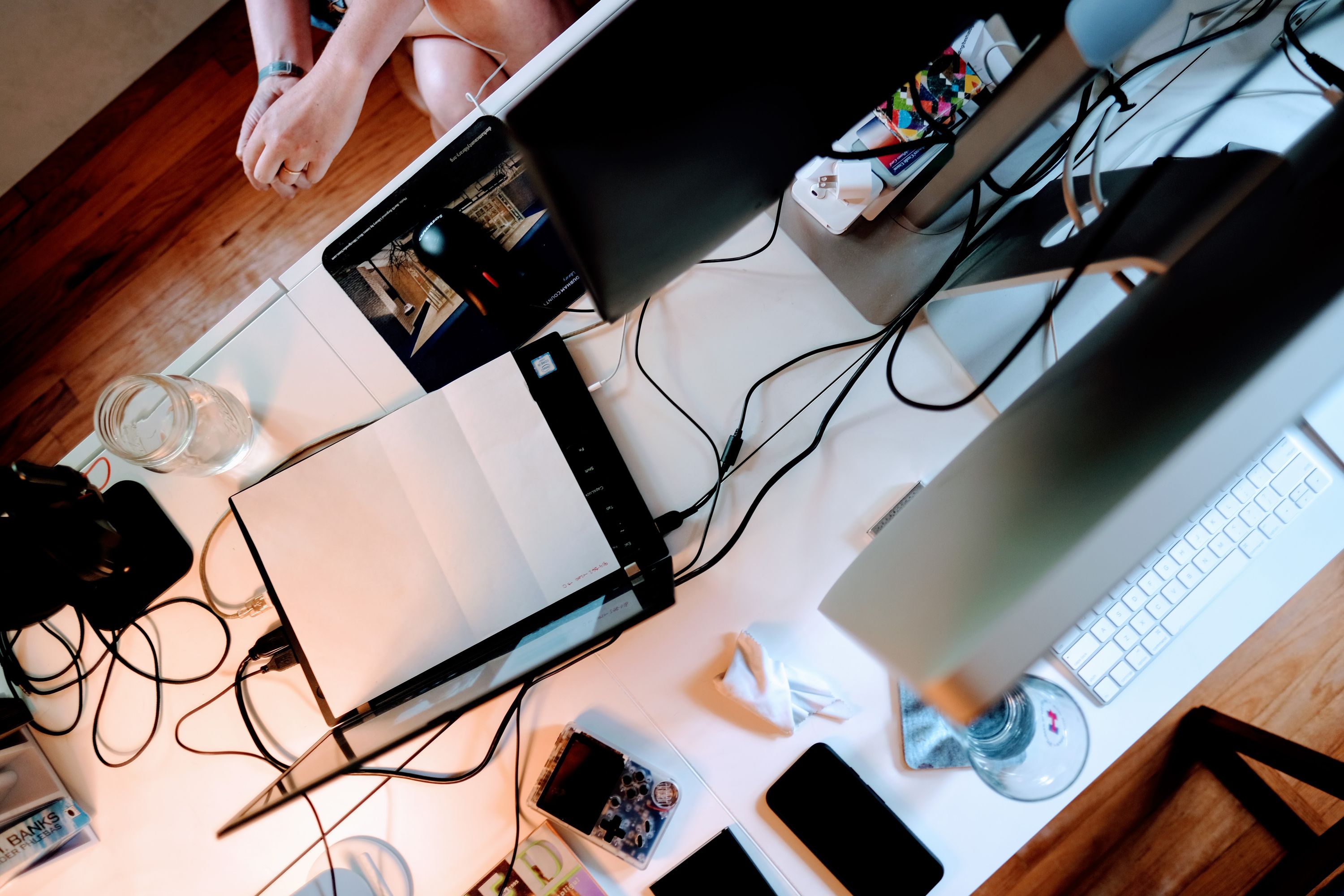
If I’m sitting at my side of our work-island, I can look left and see the side of the room given over to whatever our daughter wants to do or make. We’ll take a closer look at her pictures in a moment, because I’m proud like that. But the views are cool.

Oh, and see that cylindrical lamp? I love that thing. I made it 17 years ago for my first apartment after college in Providence, RI. A friend and I had been walking around the city, and I found that piece of clear PVC and knew I had to make something out of it. Just a few blocks later, I trash-picked the lamp. When I got home, I duo-tacked a strip of wax paper around the PVC where the light bulb would be, carved a notch in the bottom for the lamp’s cord, and the rest is history. I’m a firm believer in If You Can Make It, Make It.
(For those of you keenly inspecting these pictures, that glass of water gives away my politics. But if you’ve been reading what I write since, say, mid-2016, you’d know all about that already.)
If I turn to the right, I can look out the window and enjoy the greenery.
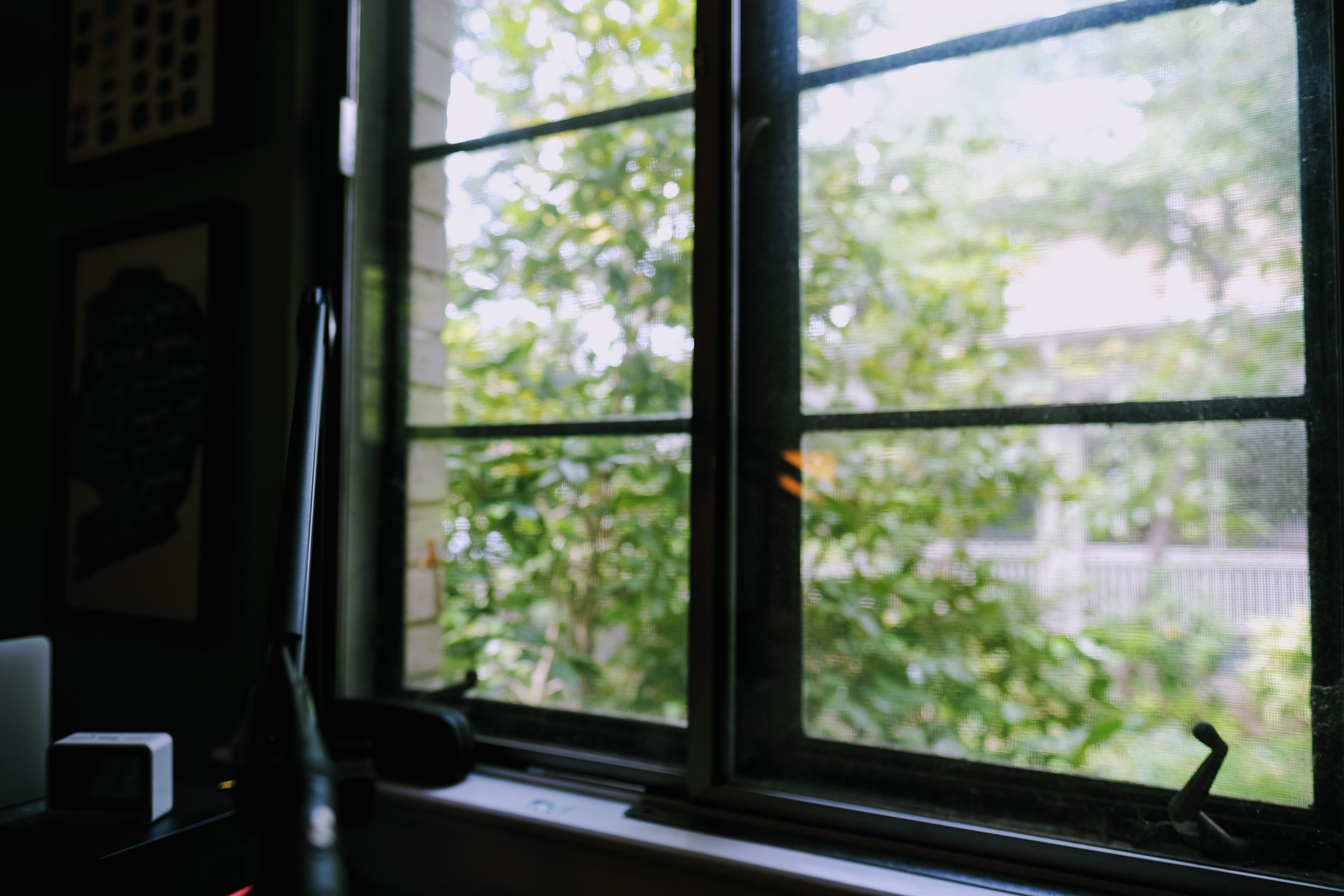
After lunchtime, the sun starts to move in that direction, so the light gets much more direct and bright in the afternoon.
By the way, our house was built in 1952 and has these wonderful windows. There’s an interior-facing set of sliding panels that, when open, allow you to crank the exterior iron and glass windows open while the screens remain in place. All the hardware is original, and most of it even still works. I wasn’t sold on them aesthetically when we first moved in, but I’ve come to love them fiercely since. Sitting here so much has given me lots of opportunity to appreciate them.
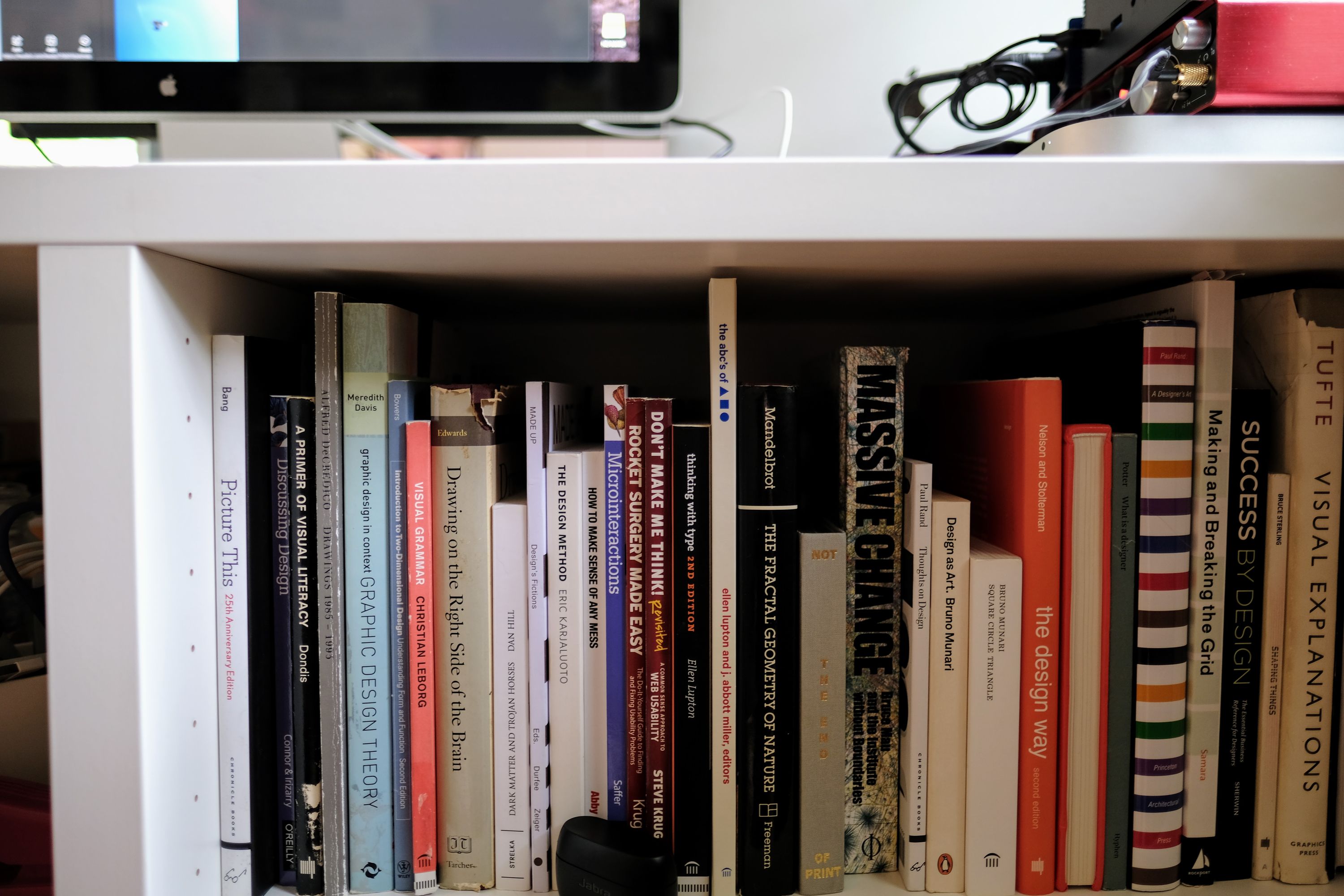
When I re-purposed these shelves and made them a workstation, I also pulled the doors off of them to make the shelves accessible while you sit in front of them. I keep some of my design books right below my screen for easy access. My favorite ones are the visual literacy texts. I even wrote a twitter thread once about them.
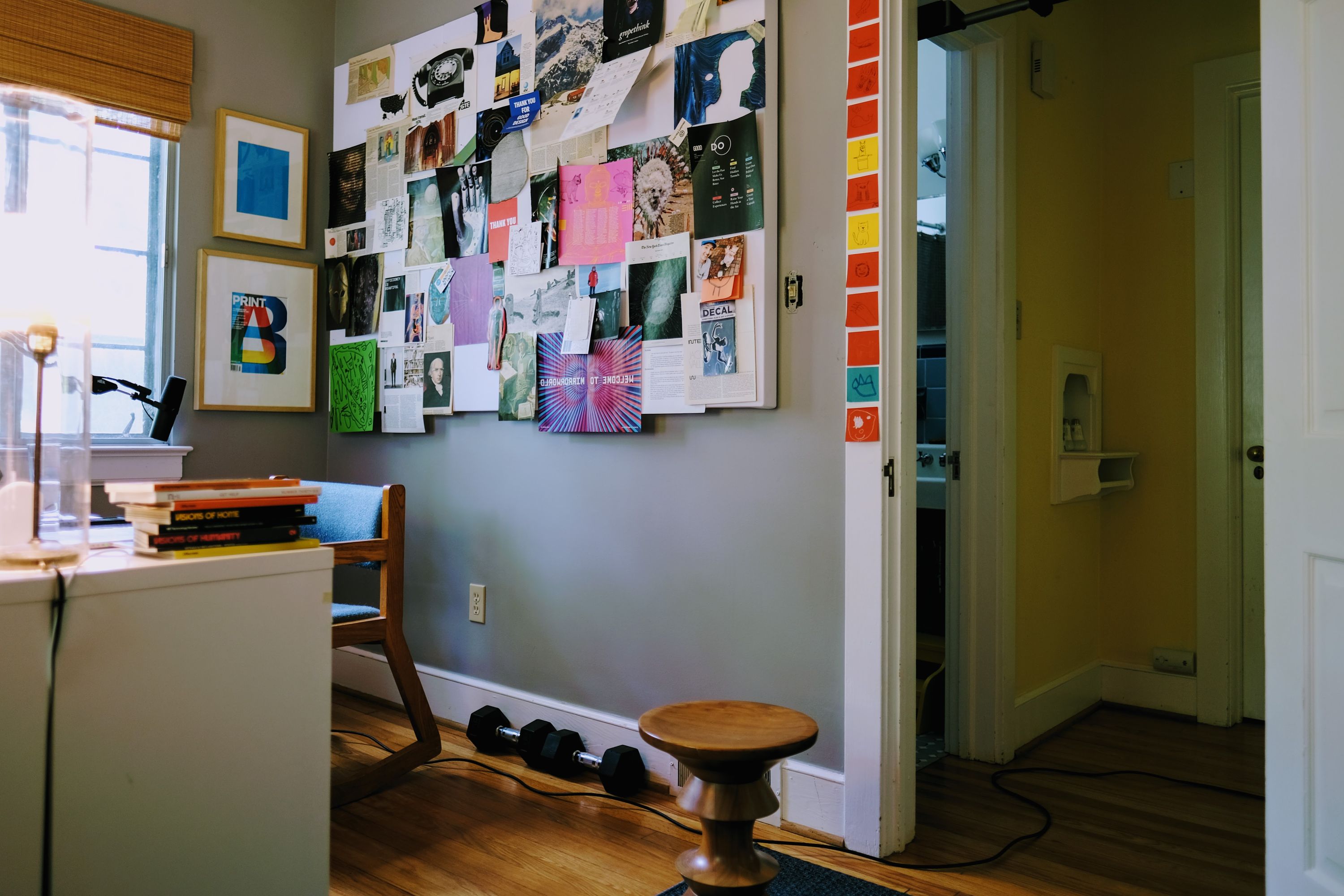
Our office is actually one of the bedrooms in our little house, which, if you saw it from the street, you might think something of a TARDIS. Everyone who comes through the front door and rounds the first corner remarks on how much smaller they expected the space to be. That’s part of its magic.
From this view you can see past the office door and a bit through the first door on the left, to an untouched, fifties era blue bathroom. Across the hall is a door to another bedroom. In between them is one of those built-in telephone shelves that houses of the 1950s often had. Back then, most homes had one telephone stuck in a central place for everyone to use. Imagine that! But the funny thing is that when we first moved here seven years ago, I wanted to find a way to get rid of that shelf. It was useless and it looked weird. It bothered me. But now I feel it must stay. I even kind of like it. Part of a house’s magic is in how it makes you feel over time. How it remakes you to fit better in it. That is, if you let it.
Stray details that speak to the unmanicured reality of the scene:
- light switch with no plate
- ethernet cable that I spool and unspool every day because I’m hesitant to drill into the floor of the office and commit to its present layout
- dumbbells and doorway pull-up bar because this is also a gym
- doorway trim in need of fresh paint
- the post-it note drawings my wife made when our daughter requested pictures of animals be drawn for her
- etc.

Ok, so imagine my face floating in the middle here, and then you’ll know what people who Zoom with me see. I’m using a few acoustic panels hung on the wall as a pinboard, which I think of as my “paper internet.”
Seriously, though, you really should have a paper internet. (I tweet about this often.) Why? Well, when I was in art school, one of the assignments we were given by our art history professor was to go sit in the museum and look at a (randomly assigned) piece of art for several days in a row, each time for at least an hour. We were free to sketch it and take notes, but not to take photographs. The point was to look at it with our own eyes — really study it — and come to know it in some personal way over time. What I learned from that experience was that displaying art is a commitment to looking at the same image, day after day, for years. Possibly even a lifetime. It’s an investment in the idea that, as images change the way we see, what we see also changes.
Of course, you don’t need framed art for this feedback loop to work for you. Any image will do! If something catches your eye in a context created for little more than the fleeting glance, all the more reason to yank it out of there and give it more time and space. Put it with other “fast” images and see what happens. The pairings on this wall create all kinds of fascinating relationships and ideas, especially when seen every day. That’s what the paper internet is all about.
I keep this paper wall because, like the internet, its random juxtapositions of information shape how I see and think. But unlike the internet, I control this wall, which means it can do the shaping in the opposite way the internet does. It’s slower, and its intentions are mine and mine alone.
Some of these scraps have lasted for years. That picture of Bucky? I’ve had that hung up in my workspace — in probably seven different rooms — for the last 15 years. The founding father wearing Google Glass? I saw that in the Times in 2014 and thought it was so funny that I pinned it up and never took it down. Others things have been added just recently. It’s constantly changing.

This is our daughter’s corner. She’s constantly making things.
She recently got so into drawing faces that she knocked out 75 of them in one sitting, and every last inch of wall in this room was covered in variations of the same face for a couple of days. It was pretty neat.
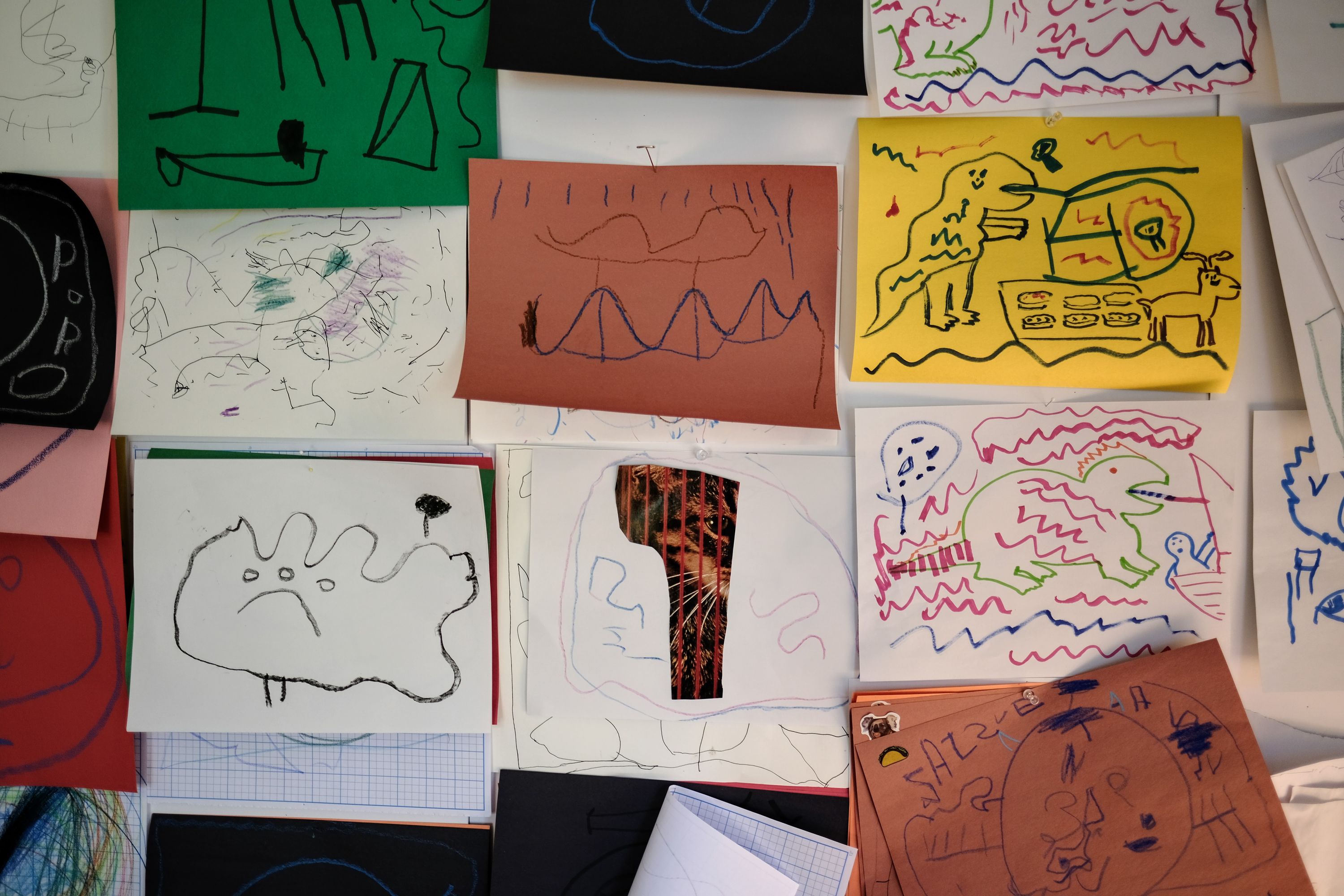
Here’s a close-up of her wall. See that picture in the middle? She told me that’s a bridge with a thunderstorm over it. She’s super into bridges and thunderstorms right now and her favorite genre of YouTube video might be either ambient video screensavers, like “10 hours of thunderstorm ambience,” or drone tours of cities, especially those with bridges.
Being a parent of a three-year-old means you get to rediscover the world by way of all these different tips of icebergs and marvel at what a wacky world they must depict for kids who have no way to fathom the rest of things!
Here’s her table, as she left it just moments before I took this picture.
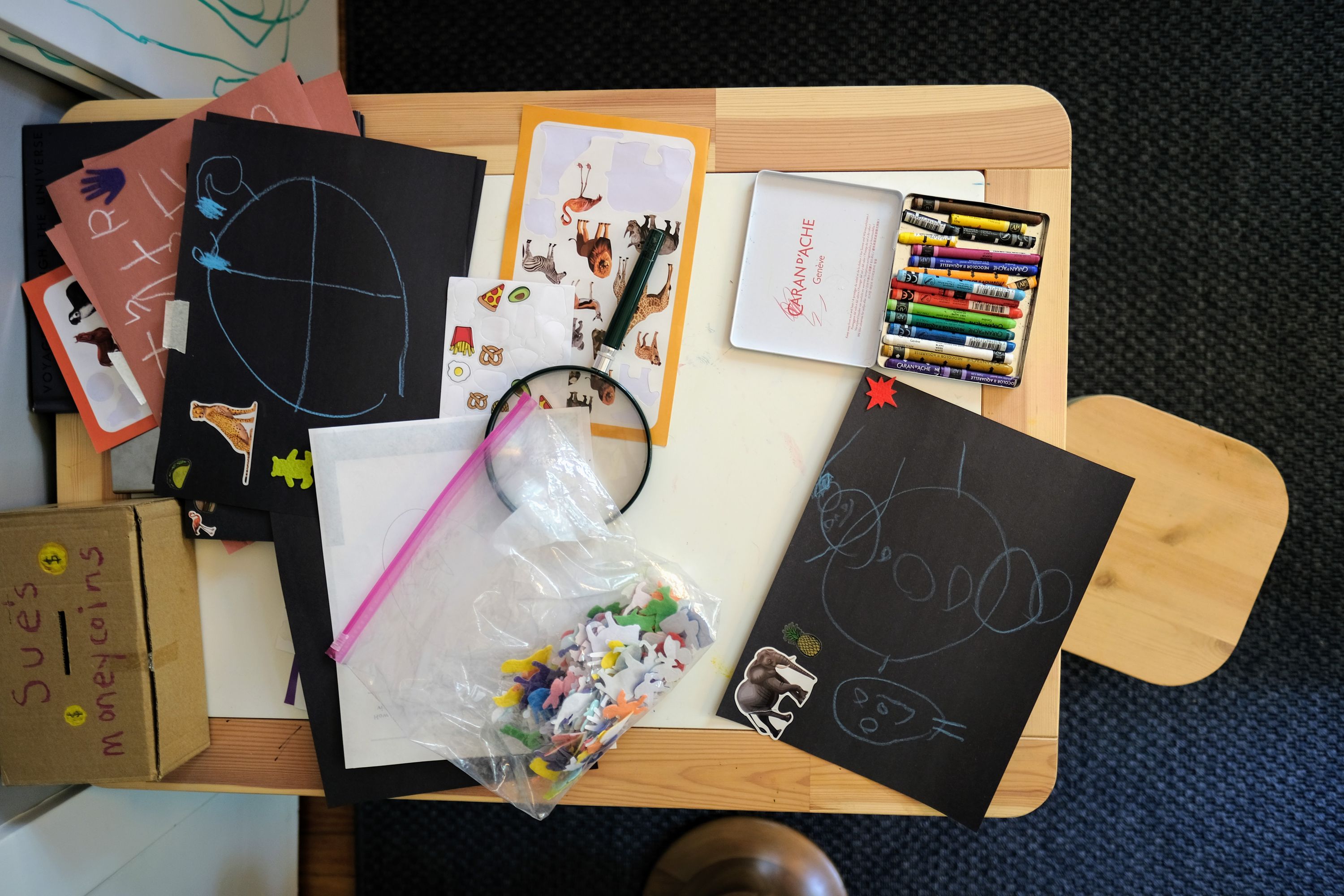
Being in this space for these months with the people I love most has provoked a lot for me. I’m thinking of so many things differently. Time, of course — what I do with it and what that says about who I am; the kind of life I want to live and what needs to be sacred from now on; the world around me and what I used to think was true and know now to be otherwise… I could do on. This has been a reckoning. It’s been scary but it’s been good.
But if there’s a single theme that keeps resonating for me, not just right now, as a somewhat Type-A person co-working with two who are not, and not just over the last few months, as we all learn to deal with big, scary, outside threats to not only the order of our lives but our lives themselves, and not just over the last four years as we’ve come to acknowledge dysfunctional and dangerous truths in our society that the election of a president can unmask and lay bare, but really for the entire last decade of my life, it’s that most things are messy and out of my control and they are to be accepted — not denied — before they are changed.
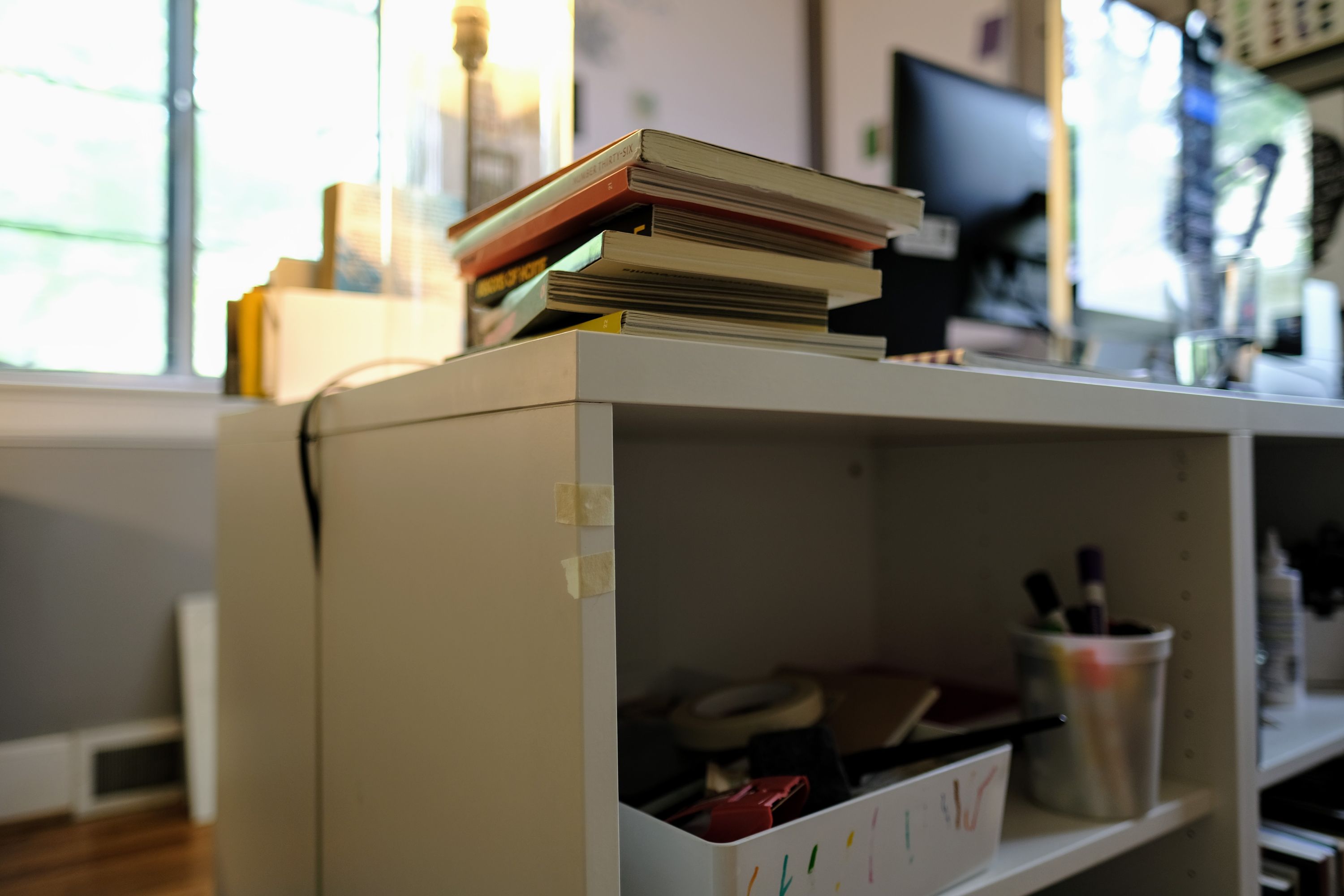
Look there, at those two pieces of tape stuck to the shelf, or the impromptu graffiti my daughter left on one of her bins. Every day, I notice a new little thing like that — something I have the impulse to clean up or fix, to restore to its original “perfection.” But what I know now is that nothing was ever perfect. And disorder from my perspective may very well be the opposite from someone else’s. My daughter put that tape there for a reason. She drew those lines on that bin for a reason. It doesn’t matter if that reason still exists or will ever make sense to me. I don’t fix every thing that I notice like that because this is not my space to control. It’s our space, and honestly, I don’t want to control it. That doesn’t mean I don’t want a tidy space — I do! It just means that little things like this — trivial and quite possibly meaningless as they may be taken at face value — can call to mind for me some larger meaning, some lesson I need to learn, some impulse in me I need to acknowledge and change. I cherish those chances to be better. That I can do so while stuck in this little box-shaped world is nothing short of a miracle.
If little things can do that, what, then, of the big things?
I didn’t set out to write about this room as an allegory for anything, but it has dawned on me that our individual confinements — and especially the challenges we endure in them — are just our own, home-sized versions of our larger reality. We are all confined to this world, together, for better and for worse. There’s nowhere else to go.
So much needs to change. The balance of power needs to shift. People need to be healed. The very structure of our created world is rotting beneath us. Because we didn’t build it right.
But that doesn’t mean it can’t be rebuilt better for all who inhabit it, not just the few who claim to be its owners. But first, we have to see it for what it is. And after that, people need to change. Most of them need to change in the same way I need to change for my daughter — to let go of the control they once had, to listen to someone else’s needs, to figure out how they can be of support, even if it’s simply to get out of their way. It’s from that vantage point that their best work can be done, listening and laboring for the ones who will inherit a world made better after they are gone.
Christopher Butler, July 1, 2020
Filed under: Essays